西班牙习俗英文介绍
- 格式:ppt
- 大小:30.47 MB
- 文档页数:30
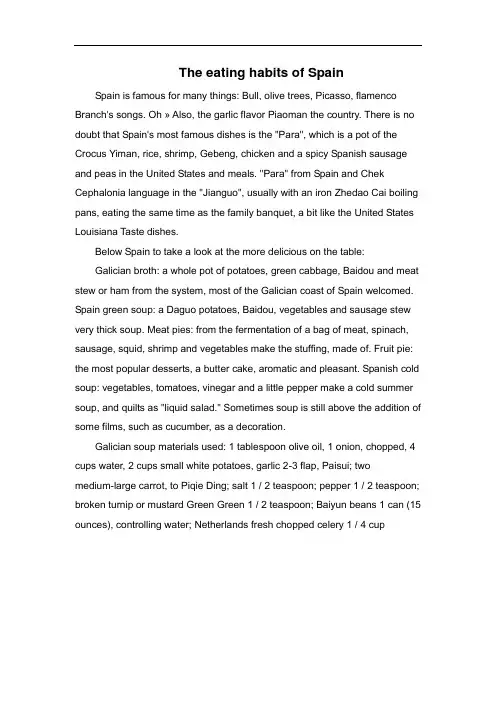
The eating habits of SpainSpain is famous for many things: Bull, olive trees, Picasso, flamenco Branch's songs. Oh » Also, the garlic flavor Piaoman the country. There is no doubt that Spain's most famous dishes is the "Para", which is a pot of the Crocus Yiman, rice, shrimp, Gebeng, chicken and a spicy Spanish sausage and peas in the United States and meals. "Para" from Spain and Chek Cephalonia language in the "Jianguo", usually with an iron Zhedao Cai boiling pans, eating the same time as the family banquet, a bit like the United States Louisiana Taste dishes.Below Spain to take a look at the more delicious on the table:Galician broth: a whole pot of potatoes, green cabbage, Baidou and meat stew or ham from the system, most of the Galician coast of Spain welcomed. Spain green soup: a Daguo potatoes, Baidou, vegetables and sausage stew very thick soup. Meat pies: from the fermentation of a bag of meat, spinach, sausage, squid, shrimp and vegetables make the stuffing, made of. Fruit pie: the most popular desserts, a butter cake, aromatic and pleasant. Spanish cold soup: vegetables, tomatoes, vinegar and a little pepper make a cold summer soup, and quilts as "liquid salad." Sometimes soup is still above the addition of some films, such as cucumber, as a decoration.Galician soup materials used: 1 tablespoon olive oil, 1 onion, chopped, 4 cups water, 2 cups small white potatoes, garlic 2-3 flap, Paisui; twomedium-large carrot, to Piqie Ding; salt 1 / 2 teaspoon; pepper 1 / 2 teaspoon; broken turnip or mustard Green Green 1 / 2 teaspoon; Baiyun beans 1 can (15 ounces), controlling water; Netherlands fresh chopped celery 1 / 4 cupSystem of law: take the pot hot oil, Add to onions and garlic, fried 4 minutes, add water, potatoes, radish and dry materials. Fire in 20-25 minutes, occasionally Fandong. Add to Luobu Ding, Yundou and the Netherlands-qin, and then burned five minutes. Fire Commissioner of the rice for 10 minutes. To make soup even some thick, can be used spoon in the pot back wall of the crowded potatoes broken. Chuguo bowl loaded with crispy bread to eat.Grilled squid salad materials: one pounds of fresh squid, cleaned; olive oil 1 / 2 cup; garlic 6-8 flap, Paisui; chopped fresh parsley 2-3 spoons; lemon juice (from 1 Lemon squeezed out), black pepper 1 / 2 teaspoon; salt 1 / 2 teaspoon; colored leaves or leaf lettuce 1, Wash; two tomatoes, chopped to nuclear; one red onion, cut long; 1 cucumber, sliced; Suanla sand Division 1 / 2 cup System of law: the oil, garlic, parsley, lemon juice and seasonings Add to bowl Leveling Draw Frame. Add to squid again, and then placed in the refrigerator 2-3 hours. The lettuce, tomato, onion, cucumber and Suanla sand Secretary Bancheng salad. Preheat oven, burning of carbon-wang, Grill Oiler. Squid will be removed from the pickle juice, on the Grill, bake 5-7 minutes each side, until the roast is Shutou. Kaohao remove the squid, placed on the salad can be consumed.。

西班牙传统节日之狂欢节Los carnavales:Tenerife y CádizLos carnavales son fiestas populares muy antiguas que se celebran cuarenta días antes de Semana Santa. Son festejos que muestran la "rebeldía" del pueblo ante los cuarenta días de Cuaresma que se avecinan.狂欢节是在“圣周”之前40天举行的一个很古老很流行的节日。
(举行的)庆祝活动都是在快临近的“大斋期”前40天展现出人的“叛逆”。
Los carnavales de Tenerife y de Cádiz son los más famosos de España.A partir del siglos ⅩⅨ, estos carnavales tienen un estilo propio.特内里费岛和加的斯省是西班牙举行狂欢节最出名的地方。
从19世纪开始,这里的狂欢节就具有当地的特色。
Su característica más importante es el humor:la gente disfrazada canta durante estos días unas canciones que ellos mismos crean.最突出的特色是幽默:人们会在这些天表演他们自己创作的歌曲。
Estas canciones cuentan y critican con mucha gracia hechos sociales, políticos, etc.,ocurridos durante el añ gente se echa a la calle,entona canciones con su "murga" (grupo de amigos),y toca el pito y el bombo.这些歌曲诙谐地描述和批判了这一年里发生关于的社会,政治等事件。
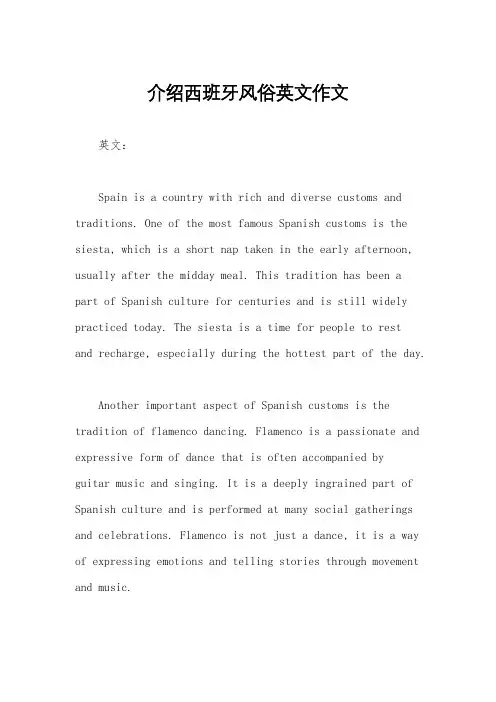
介绍西班牙风俗英文作文英文:Spain is a country with rich and diverse customs and traditions. One of the most famous Spanish customs is the siesta, which is a short nap taken in the early afternoon, usually after the midday meal. This tradition has been apart of Spanish culture for centuries and is still widely practiced today. The siesta is a time for people to restand recharge, especially during the hottest part of the day.Another important aspect of Spanish customs is the tradition of flamenco dancing. Flamenco is a passionate and expressive form of dance that is often accompanied byguitar music and singing. It is a deeply ingrained part of Spanish culture and is performed at many social gatherings and celebrations. Flamenco is not just a dance, it is a way of expressing emotions and telling stories through movement and music.Bullfighting is also a traditional custom in Spain, although it is a controversial one. The spectacle is deeply rooted in Spanish history and is considered by many to be an art form. However, it has also been the subject of much debate and criticism, particularly from animal rights activists. Despite this, bullfighting continues to be a popular and significant part of Spanish culture.In addition to these customs, Spain is also known for its lively and colorful festivals, such as La Tomatina and the Running of the Bulls. These events attract visitors from all over the world and are a testament to the Spanish people's love for celebration and enjoyment.中文:西班牙是一个拥有丰富多样风俗和传统的国家。

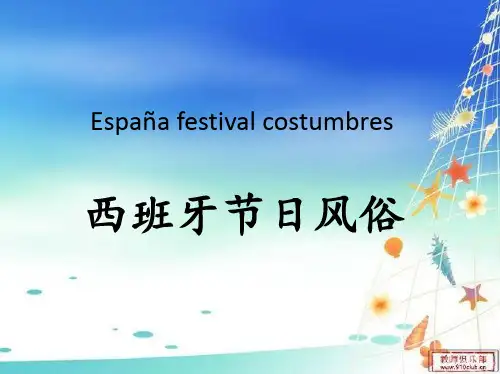
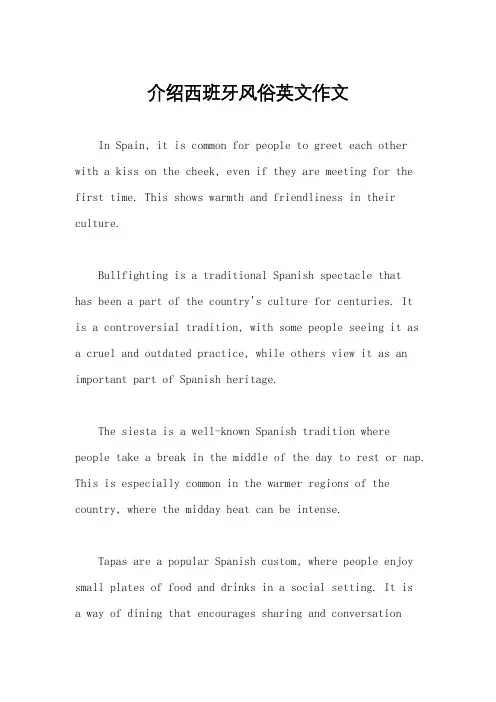
介绍西班牙风俗英文作文In Spain, it is common for people to greet each other with a kiss on the cheek, even if they are meeting for the first time. This shows warmth and friendliness in their culture.Bullfighting is a traditional Spanish spectacle thathas been a part of the country's culture for centuries. Itis a controversial tradition, with some people seeing it as a cruel and outdated practice, while others view it as an important part of Spanish heritage.The siesta is a well-known Spanish tradition where people take a break in the middle of the day to rest or nap. This is especially common in the warmer regions of the country, where the midday heat can be intense.Tapas are a popular Spanish custom, where people enjoy small plates of food and drinks in a social setting. It isa way of dining that encourages sharing and conversationamong friends and family.Flamenco is a traditional Spanish dance and music style that is known for its passionate and emotional performances. It is a deeply ingrained part of Spanish culture and isoften performed at festivals, weddings, and other special occasions.The Spanish have a strong tradition of celebrating festivals and holidays, with each region having its own unique customs and traditions. From the famous Running of the Bulls in Pamplona to the colorful and vibrant Carnival celebrations, these events are an important part of Spanish culture.。
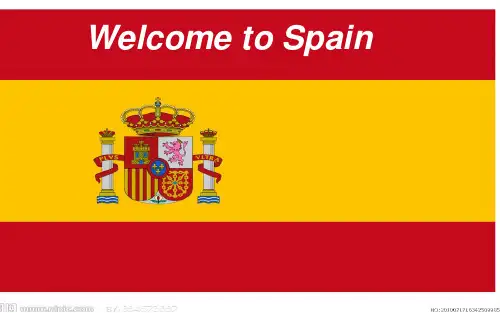
Kingdom of Spain ⏹The geography of Spain⏹The famous of city⏹Spanish culture1、bullfighting (Running of the Bulls)2、Tomato Carnival3、wine and food4、flamenco⏹other famousIt is a country located in southwestern Europe on the Iberian Peninsula. Its mainland is bordered to the south and east by the Mediterranean Sea except for a small land boundary with Gibraltar; to the north by France, Andorra, and the Bay of Biscay; and to the west by the Atlantic Ocean and Portugal. Spanish territory also includes the Balearic Islands in the Mediterranean, the Canary Islands in the Atlantic Ocean off the African coast, and two autonomous cities in North Africa, Ceuta and Melilla, that border Morocco. With an area of 504,030 km?, Spain is the second largest country in WesternMadrid马德里(Madrid),西班牙首都,全国第一大城市,全国经济、交通中心,马德里省首府。
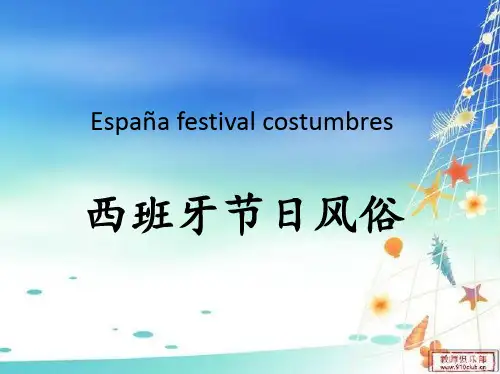
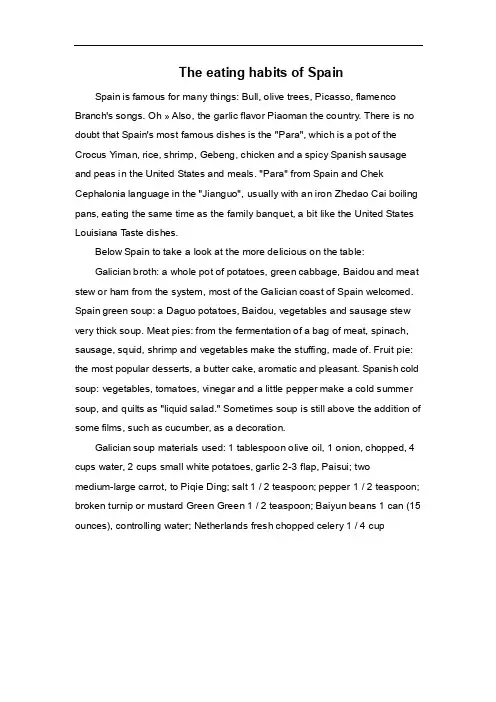
The eating habits of SpainSpain is famous for many things: Bull, olive trees, Picasso, flamenco Branch's songs. Oh » Also, the garlic flavor Piaoman the country. There is no doubt that Spain's most famous dishes is the "Para", which is a pot of the Crocus Yiman, rice, shrimp, Gebeng, chicken and a spicy Spanish sausage and peas in the United States and meals. "Para" from Spain and Chek Cephalonia language in the "Jianguo", usually with an iron Zhedao Cai boiling pans, eating the same time as the family banquet, a bit like the United States Louisiana T aste dishes.Below Spain to take a look at the more delicious on the table:Galician broth: a whole pot of potatoes, green cabbage, Baidou and meat stew or ham from the system, most of the Galician coast of Spain welcomed. Spain green soup: a Daguo potatoes, Baidou, vegetables and sausage stew very thick soup. Meat pies: from the fermentation of a bag of meat, spinach, sausage, squid, shrimp and vegetables make the stuffing, made of. Fruit pie: the most popular desserts, a butter cake, aromatic and pleasant. Spanish cold soup: vegetables, tomatoes, vinegar and a little pepper make a cold summer soup, and quilts as "liquid salad." Sometimes soup is still above the addition of some films, such as cucumber, as a decoration.Galician soup materials used: 1 tablespoon olive oil, 1 onion, chopped, 4 cups water, 2 cups small white potatoes, garlic 2-3 flap, Paisui; twomedium-large carrot, to Piqie Ding; salt 1 / 2 teaspoon; pepper 1 / 2 teaspoon; broken turnip or mustard Green Green 1 / 2 teaspoon; Baiyun beans 1 can (15 ounces), controlling water; Netherlands fresh chopped celery 1 / 4 cupSystem of law: take the pot hot oil, Add to onions and garlic, fried 4 minutes, add water, potatoes, radish and dry materials. Fire in 20-25 minutes, occasionally Fandong. Add to Luobu Ding, Yundou and the Netherlands-qin, and then burned five minutes. Fire Commissioner of the rice for 10 minutes. T o make soup even some thick, can be used spoon in the pot back wall of the crowded potatoes broken. Chuguo bowl loaded with crispy bread to eat.Grilled squid salad materials: one pounds of fresh squid, cleaned; olive oil 1 / 2 cup; garlic 6-8 flap, Paisui; chopped fresh parsley 2-3 spoons; lemon juice (from 1 Lemon squeezed out), black pepper 1 / 2 teaspoon; salt 1 / 2 teaspoon; colored leaves or leaf lettuce 1, Wash; two tomatoes, chopped to nuclear; one red onion, cut long; 1 cucumber, sliced; Suanla sand Division 1 / 2 cup System of law: the oil, garlic, parsley, lemon juice and seasonings Add to bowl Leveling Draw Frame. Add to squid again, and then placed in the refrigerator 2-3 hours. The lettuce, tomato, onion, cucumber and Suanla sand Secretary Bancheng salad. Preheat oven, burning of carbon-wang, Grill Oiler. Squid will be removed from the pickle juice, on the Grill, bake 5-7 minutes each side, until the roast is Shutou. Kaohao remove the squid, placed on the salad can be consumed.教你如何用WORD文档(2012-06-27 192246)转载▼标签:杂谈1. 问:WORD 里边怎样设置每页不同的页眉?如何使不同的章节显示的页眉不同?答:分节,每节可以设置不同的页眉。

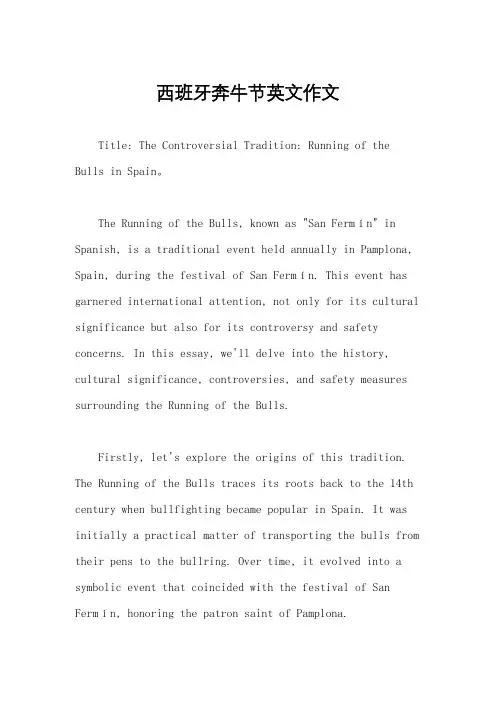
西班牙奔牛节英文作文Title: The Controversial Tradition: Running of the Bulls in Spain。
The Running of the Bulls, known as "San Fermín" in Spanish, is a traditional event held annually in Pamplona, Spain, during the festival of San Fermín. This event has garnered international attention, not only for its cultural significance but also for its controversy and safety concerns. In this essay, we'll delve into the history, cultural significance, controversies, and safety measures surrounding the Running of the Bulls.Firstly, let's explore the origins of this tradition. The Running of the Bulls traces its roots back to the 14th century when bullfighting became popular in Spain. It was initially a practical matter of transporting the bulls from their pens to the bullring. Over time, it evolved into a symbolic event that coincided with the festival of San Fermín, honoring the patron saint of Pamplona.The cultural significance of the Running of the Bulls cannot be understated. For the people of Pamplona and many visitors, it represents a deeply ingrained tradition that celebrates bravery, adrenaline, and a sense of community. The event draws participants and spectators from all over the world who come to experience the thrill and spectacle of the bull run.However, the event is not without its controversies. Animal rights activists vehemently oppose the Running of the Bulls, arguing that it subjects the bulls to unnecessary stress, fear, and injury. They advocate for the abolition of bullfighting and related events, citingethical concerns about animal welfare.Moreover, safety concerns have plagued the event for years. The narrow, crowded streets of Pamplona become chaotic as both bulls and runners navigate through them. Every year, there are reports of injuries, ranging from minor bruises to severe goring. Critics argue that the event prioritizes tradition over safety, puttingparticipants and even bystanders at risk of harm.To address these concerns, organizers have implemented various safety measures in recent years. These include erecting barricades along the route, increasing the number of medical personnel on standby, and enforcing stricter rules for participants. Additionally, educational campaigns aim to raise awareness about the risks involved and encourage responsible behavior during the event.Despite these efforts, the Running of the Bulls continues to spark debate and controversy. Supporters view it as an integral part of Spanish culture and heritage, while opponents condemn it as cruel and dangerous. Finding a balance between preserving tradition and ensuring safety and ethical treatment of animals remains a ongoing challenge for organizers and policymakers.In conclusion, the Running of the Bulls in Spain is a complex and multifaceted event that elicits strong emotions and opinions. While it holds deep cultural significance for many, it also faces criticism and scrutiny from variousquarters. As society evolves, so too must our approach to traditional events like this, taking into account ethical, safety, and cultural considerations.。
西班牙有什么特点和风俗英语作文Spain is a country with rich cultural heritage and diverse traditions. It is known for its vibrant and lively atmosphere, delicious cuisine, and passionate people. Here are some of the key characteristics and customs of Spain:1. Festivals and Celebrations: Spain is famous for its numerous festivals and celebrations throughout the year. From the iconic Running of the Bulls in Pamplona to the colorful and lively Feria de Abril in Seville, there is always something to celebrate in Spain. These festivals are a reflection of the Spanish people's love for life andtheir strong sense of community.2. Siesta: The siesta, a short nap taken in the early afternoon, is a well-known tradition in Spain. It is a time for people to rest and recharge before continuing withtheir day. Many shops and businesses close for a few hours during the afternoon to accommodate this tradition.3. Flamenco: Flamenco is a passionate and expressive art form that originated in the Andalusian region of Spain. It is characterized by its intricate footwork, dramatic handmovements, and soulful music. Flamenco is an integral partof Spanish culture and is often performed at festivals, weddings, and other special occasions.4. Tapas and Paella: Spanish cuisine is world-renownedfor its delicious and diverse flavors. Tapas, small platesof appetizers and snacks, are a popular way to enjoy a variety of dishes in one sitting. Paella, a traditional Spanish rice dish, is also a staple of Spanish cuisine andis often enjoyed with family and friends during gatherings.5. Bullfighting: Bullfighting is a controversialtradition in Spain that has been a part of the country's culture for centuries. While it has faced criticism in recent years, it remains a significant cultural event for many Spaniards.6. Religious Festivals: Spain is a predominantlyCatholic country, and religious festivals play asignificant role in Spanish culture. Semana Santa, or Holy Week, is a particularly important religious festival thatis celebrated with processions, music, and traditional food.7. Soccer: Soccer, or football as it is known in Spain,is a passion for many people in the country. The Spanishnational team has a strong following, and the country is home to several world-renowned soccer clubs, such as Real Madrid and FC Barcelona.These are just a few of the many traditions and customs that make Spain a unique and fascinating country.西班牙是一个拥有丰富文化遗产和多样传统的国家。
西班牙奔牛节英文作文The Running of the Bulls is a traditional festival held in Pamplona, Spain, every year in July. It involves a group of bulls running through the streets of the city, while people try to outrun them. This festival is a major attraction for tourists from all over the world.The festival has a long history and is deeply rooted in Spanish culture. It is believed to have originated in the 14th century, when farmers would run in front of the bulls to take them to the bullring. Over time, the tradition evolved into a festival that attracts thousands of people every year.The festival is not without controversy, however. Animal rights activists have long criticized the event, arguing that it is cruel to the bulls. In recent years, there have been calls to ban the festival altogether. Despite this, the festival continues to be a major event in Spain, and many people argue that it is an importantcultural tradition.The festival is not just about running with the bulls, however. There are also parades, music, and dancing, as well as plenty of food and drink. The atmosphere in Pamplona during the festival is electric, with people from all over the world coming together to celebrate.For those who do decide to run with the bulls, it is important to remember that it is a dangerous activity. Every year, there are injuries and even deaths as a result of the festival. It is important to take the necessary precautions and to be aware of the risks involved.Overall, the Running of the Bulls is a unique and exciting festival that is deeply ingrained in Spanish culture. While it may not be for everyone, it is certainly an experience that those who participate will never forget.。
西班牙有什么特点和风俗英语作文Spain is a captivating country that boasts a rich cultural heritage, vibrant traditions, and a diverse landscape. From the sun-drenched beaches of the Balearic Islands to the majestic Pyrenees mountains, Spain offers a captivating blend of history, art, and gastronomy that enchants visitors from around the world.One of the most striking features of Spain is its regional diversity. Each autonomous community within the country has its own distinct identity, language, and customs, creating a tapestry of cultural riches. In the northern region of Catalonia, the Catalan language and traditions thrive, with iconic landmarks like the Sagrada Familia in Barcelona and the medieval towns of Girona. Further south, Andalusia is renowned for its Moorish influence, exemplified by the stunning Alhambra palace in Granada and the flamenco dance that originated in this region.The Spanish way of life is centered around the concept of "convivencia," which emphasizes the importance of shared experiences and social connections. This is evident in the country's vibrant outdoor culture, where locals and visitors alike gather in plazas, cafes, and tapas bars to savor the local cuisine and engage inlively conversations. The tradition of the "siesta," a midday break for rest and relaxation, is deeply ingrained in the Spanish psyche, reflecting the country's laid-back and unhurried approach to life.One of the most captivating aspects of Spanish culture is its rich artistic heritage. From the surreal masterpieces of Pablo Picasso and Salvador Dalí to the architectural wonders of Antoni Gaudí, Spain has long been a hub of artistic innovation and creativity. The country's museums, such as the Prado in Madrid and the Guggenheim in Bilbao, showcase the works of these and other renowned artists, offering visitors a glimpse into the country's cultural legacy.The Spanish culinary landscape is equally impressive, with each region boasting its own unique specialties and flavors. Tapas, a tradition of small shared plates, has become a global phenomenon, with Spanish restaurants around the world serving up delectable bites like jamón ibérico, patatas bravas, and tortilla española. The country's wine regions, such as Rioja and Ribera del Duero, produce world-class vintages that have earned global acclaim.Beyond its cultural riches, Spain is also renowned for its natural beauty. The Balearic Islands, with their crystal-clear waters and white-sand beaches, offer a tropical escape, while the rugged landscapes of the Pyrenees and the Picos de Europa mountain ranges provide ample opportunities for outdoor adventures. The Canary Islands,situated off the northwest coast of Africa, are a popular destination for their volcanic landscapes and year-round mild climate.In conclusion, Spain is a country that captivates the senses and leaves a lasting impression on all who visit. From its vibrant regional cultures and artistic heritage to its delectable cuisine and breathtaking natural landscapes, Spain offers a truly unique and unforgettable experience. Whether you're exploring the winding streets of Seville, indulging in a tapas crawl in Madrid, or hiking through the stunning Pyrenees, there is always something new to discover in this enchanting land.。